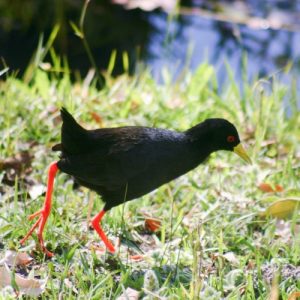Listen to a Sample
It is dawn in the Karoo Gariep Nature Reserve in the heart of this vast semi-desert region. It is a birder’s paradise and nature lover’s retreat. Of the 205 bird species recorded on the reserve one of the most spectacular is the stately Blue Crane, South Africa’s national bird.
Each evening large numbers of cranes spend the night roosting in the shallows of a huge dam together with an exciting array of waterbirds. As it becomes light the honking and hooting of many South African Shelduck competes with the nasal rattling call of the cranes. A flock of Merino sheep add to the morning chorus. Then several Blue Cranes take flight as they head to nearby feeding grounds, calling loudly. In between Egyptian Geese give their loud honking calls.
A tiny Grey-backed Cisticola gives its gentle bubbling call at regular intervals and then another endemic species, the brilliantly coloured Bokmakierie (a member of the shrike family) gives one of its many melodious whistled songs, calling in duet with a mate. The cranes call in competition as they fly overhead with loud wing beats.
At 2.50 yet another endemic, this time a Blue Korhaan (a large bustard), gives its croaking call, with other members of the flock replying. The chorus continues with Egyptian Geese flying overhead on various occasions, and the Shelduck go on with their never-ending chorus.
The Bokmakierie sings again at 7.45, the mate calling in duet in the background followed by several cranes.
The chorus continues with several grassland species calling in the distance together with the Bokmakierie. Around 18.00 a Blacksmith Lapwing calls and at 18.45 an Eastern Clapper Lark claps its wings in its aerial display. While the Bokmakierie gives a new version of its song in the foreground, the resident African Fish Eagle calls in the background at 24.18. At 26.50 a Northern Black Korhaan (another bustard species) gives its grating call, repeating it for some time.
At 28.36 a White-throated Canary sings, a series of whistles and churrs and at 30.03 the Clapper Lark gives its aerial wing-clapping display again. A Hadeda Ibis calls raucously at 31.35 with the cranes calling again together with the Bokmakierie followed by the Blue Korhaan at 34.30, the cranes continue in the background, eventually becoming dominant a short while later. The Northern Black Korhaan takes over at 36.35. Shelduck have been calling throughout the soundscape. The occasional mosquito adds its piercing buzz to the chorus.
A Swainson’s Spurfowl gives its harsh crow at 40.25 followed by several Egyptian Geese. The sheep become more vocal as the day slowly warms up and the Bokmakierie calls regularly. Most of the cranes have moved to the surrounding grassland to fed but a small group remains at the water’s edge calling intermittently with Blue Korhaans adding to the chorus.
At 49.50 a male Egyptian Goose, recognisable by its harsh hissing call, flies over the microphone. Several Eastern Clapper Larks are now giving their aerial wing-clapping displays competing with the Bokmakierie.
The bird song slowly dies down as the sun rises, cranes now only calling occasionally. Even the Shelduck are relatively quiet. At 59.08 a grasshopper makes a high-pitched chittering sound with its wings as it flies from bush to bush.
An African Hoopoe and a Bokmakierie call towards the end of the soundscape.
With the Cranes in the Karoo Soundscape – File Download Size
You will receive an email with download links once purchased.
- With the Cranes in the Karoo – FLAC (640.0 MB)
- With the Cranes in the Karoo – MP3 (55.9 MB)
- With the Cranes in the Karoo – PDF (98.1 KB)







